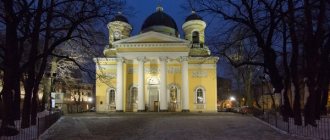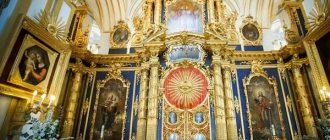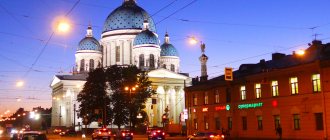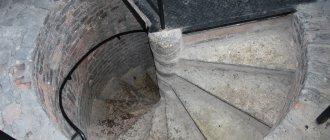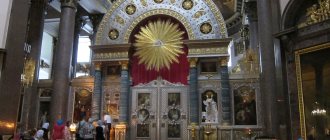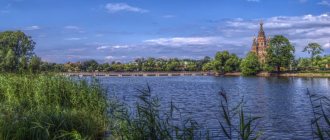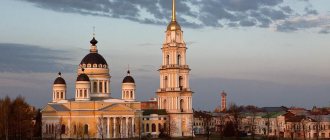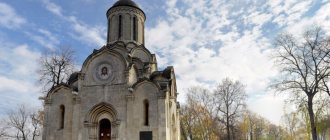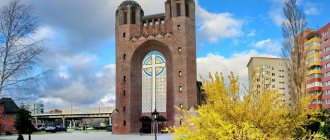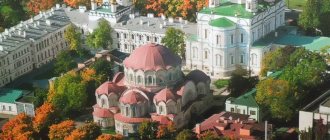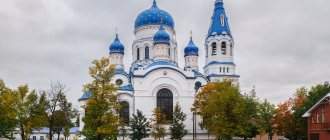St. Nicholas or St. Nicholas Cathedral , which is also called the sea cathedral, is one of the most magnificent baroque churches in St. Petersburg, with which the names of many great people are associated. It is believed that the idea of construction belonged to Peter the Great, who was struck by the beauty of the temple in Astrakhan, after which the autocrat wanted to build a similar one in his capital. However, work began already under Elizabeth, and this cathedral replaced the wooden church that stood where Nikolskaya Square is now located. Elizabeth donated icons for the temple, and later many eminent Russians, for example, Pyotr Tchaikovsky, made presents to the cathedral. Gradually, a tradition arose to bless any undertaking significant for the fleet and sailors with a service in this church.
Did you know? Even in Soviet times, the temple was not closed, and during the Leningrad blockade, Matins and Vespers were served here every day. For a long time it was a cathedral. Today there are two churches in the temple - the lower one, Nikolskaya, and the upper one, Epiphany. On the territory of the cathedral there are memorial plaques to the sailors who died on the Kursk and Komsomolets submarines.
Location and how to get there
St. Nicholas Cathedral is located at the address: St. Petersburg, Nikolskaya sq., 1-3. The intersection of the Griboedov and Kryukov canals.
To get to the cathedral, you can use the metro, bus, tram or minibus:
- Buses that take you to the cathedral are numbered 49 or 181.
- The route taxi operates under the numbers K-7, K-124, K-195, K-212.
- By tram number 3.
- In all cases, you can get off at the stops Nikolskaya Square, Novo-Nikolsky Bridge, Rimsky-Korsakov Avenue, 39.
- To get there by metro, you need to get off at Sadovaya station and get off at Sennaya Square.
How to get there?
Unfortunately, water routes were canceled this year due to low profitability, so you can now get to St. Nicholas Cathedral only by land transport:
— minibus No. 405 to Kronstadt from the Chernaya Rechka metro station to the stop at Yakornaya Square;
— minibus No. 407 to Kronstadt from the Prospekt Prosveshcheniya metro station to the stop at Yakornaya Square;
- bus No. 101 to Kronstadt from the Staraya Derevnya metro station to the stop at the House of Public Services, then walk along Sovetskaya Street to Yakornaya Square.
Activities of the parish
The cathedral has a Sunday school not only for children, but also for adults. There is also a Youth Union for people who are interested in studying Orthodoxy.
Sunday School for Adults
Meetings are held weekly on Friday at 5 pm. At meetings, church ministers raise issues of studying the Christian church and traditions of worship, as well as issues of the history of the general church church. Absolutely anyone can attend the classes.
Sunday school for children
Since the 20th century. The cathedral houses a Sunday school for children. The main purpose of education is to help children become worthy Christians. Lessons take place every Sunday from 13:00 to 14:00.
Children from 7 to 14 years old attend the school. There is also a special class for younger children. The school is taught by temple clergy.
For church holidays, students prepare productions or performances. The school offers additional classes in:
- beading;
- drawing;
- learning English.
Children participate in pilgrimage trips. During trips, children are told the history of the holy places of St. Petersburg. Enrollment into the school takes place on September 1, by the school director, Archpriest Bogdan.
Children's choir
During classes, children learn liturgical chants, after which they sing them at services. For students, a Liturgy is held once every 2 months, at which children are taught. Boys who have received the abbot's blessing can be assistants at services.
St. Nicholas Youth Union
It began operating in 2010 with the blessing of Archpriest Bogdan. People who want to study the Faith and participate in the activities of the temple join this club. In most cases, the participants of this club are parishioners of St. Nicholas Cathedral.
The Youth Union has the following goals:
- Possibility of communication. To prevent young people from feeling lonely, the club helps young people find friends and a common language.
- Spiritual education. Lectures on Christian doctrine are held for members of the union. The lectures examine such aspects of the church as: the study of Orthodoxy, knowledge of the Holy Scriptures.
- Education activities. The goal is to introduce non-believers to Orthodoxy or help those who doubt it.
- Charity. Actively helping people in need. Visiting and helping the infirm, elderly and lonely people, children in orphanages.
Club meetings are held every month.
Story
The prerequisites for the start of construction of the cathedral began to appear at the end of the 19th century, when the island of Kotlin had already acquired the status of an inhabited one: by this time a port, shipyards, docks, and a military base had been built. But until now there has never been a serious temple that would symbolize the faith and piety of the Russian army.
Of course, there was an Orthodox Church. But it, in comparison with the Lutheran chapels standing nearby, had such an unsightly appearance that the main supporter of the construction of the new church and donor, Archpriest John of Kronstadt, constantly blamed the authorities for this. According to him, this was the reason for some of Russia’s failures in the naval field. In addition, the majestic church would guard and protect Rus' from the encroachments of foreigners, since the temple is equated to the same ship, which is controlled by the Lord.
Start of construction
A wooden chapel was built for the people who built vital facilities in the early 18th century. It was built in 1730 on the territory of Morskaya Sloboda and consecrated in honor of Nicholas the Wonderworker.
In 1733, a canvas church was built on the site of the chapel. Then in 1743, a wooden church was built on the site of the canvas church. In 1752, at the request of Major Golitsyn, Elizabeth the Great signed a decree for the construction of a stone church in honor of St. Nicholas. The temple was built on the site of a wooden church. Savva Ivanovich Chevakinsky was appointed the architect of the temple.
St. Nicholas Cathedral in St. Petersburg was originally planned to be built by Peter I. When Peter saw the temple in Astrakhan, he wanted to build the same one in St. Petersburg.
Work began only in 1753. Very often there were not enough materials, so the construction of the cathedral dragged on for 9 years. In 1760, the lower church was consecrated in honor of St. Nicholas, and the upper church in honor of the Epiphany of Christ. Construction of the building was completed only in 1762. Along with the main building of the cathedral, its bell tower was built in 1758.
Church history
One of the most beautiful cathedrals and temples of St. Petersburg is closely connected with the history of the Russian navy. Even under Peter I, a Morskaya Sloboda was formed between the Moika and Fontanka, where those who worked on creating a powerful Russian fleet settled. The one-story barracks were occupied by sailors who served on warships. In memory of this, the old names have been preserved - Kanonerskaya Street and Kanonersky Lane.
For the spiritual nourishment of the sailors, in 1714, a chapel was made “in the small rooms” of the regimental yard, where priests from the Alexander Nevsky Lavra came. In 1733, a new linen church was built for the sailors in a large log hut.
Ten years later, a wooden temple was erected on the parade ground of the Marine Regimental Yard, next to the future Kryukov Canal, and a small cemetery was laid out next to it. Almost 3.5 thousand sailors were assigned to the large parish, not counting their parents, wives and children.
In 1752, Prince Mikhail Golitsyn asked the Russian Empress Elizaveta Petrovna to build a new stone church in the city and consecrate it in honor of the heavenly patron of sailors and wanderers - St. Nicholas. For construction it was supposed to use funds from the Maritime Department, “bridge” money and private contributions.
The building project was entrusted to Savva Ivanovich Chevakinsky. The talented architect was a student of Francesco Bartolomeo Rastrelli himself and served as a staff architect at the Admiralty College. As a model, he used the beautiful cathedral in Astrakhan, which Peter I really liked at one time.
In the first half of the 18th century, single-domed churches with a spire, similar to the Peter and Paul Cathedral, were erected in St. Petersburg. Chevakinsky's idea to build a five-domed cathedral caused surprise. The new St. Nicholas Church marked the return of Orthodox architecture to the traditions of pre-Petrine architecture.
In Chevakinsky's original design, the cathedral was small. But severe floods on the Neva made adjustments. To prevent river water from flooding the floor, it was decided to raise the building above the ground and significantly increase its size. The foundation stone for the new temple took place in the summer of 1753. The first stone for the foundation of the cathedral was laid by Archbishop Sylvester.
All church utensils for worship were purchased with funds from the Admiralty Board. An elegant copper chandelier was brought from Nuremberg. The icons for the cathedral were painted by famous isographers Mina and Fedot Kolokolnikov, and the carved iconostasis was made by a skilled craftsman Ignatius Kanaev. The metal structures for the domes were made in Tula at the plant of P. A. Demidov, the bells were cast at the Moscow plant of Mozzhukhin.
The lower temple was consecrated in 1760, and the upper one in 1762. Empress Catherine II, who was present at the solemn event, ordered that the temple be called the “Naval Cathedral.”
This is how his special role in the life of Russian sailors was determined. Year after year, long-awaited military victories were celebrated here, thanksgiving prayers and memorial services were held for the dead. In addition, Catherine II presented the cathedral with 10 icons in expensive gilded vestments.
Years passed, but the original appearance of the church remained almost unchanged. In the 19th century and the beginning of the last century, there was a women’s almshouse, a school, an orphanage and a charitable society at the temple. In 1901, stoves were built on the second floor of the cathedral, so the rooms became warm.
The October Revolution and the events that followed it directly affected the situation of the ancient cathedral. In 1918, the temple received parish status. A few years later, all church valuables were removed from the building - silver and gilded vessels, chasubles and crosses weighing 328 kg. The parishioners managed to buy back some of the temple relics, but in return they contributed an equal weight of silver to the treasury.
In 1933, a decision was made in Leningrad to stop ringing bells. A year later, all 13 bells weighing more than 20 tons were removed from the bell tower of St. Nicholas Cathedral and sent for melting down. For many years the cathedral remained “voiceless”.
View of the cathedral bell tower
Under Soviet rule, the temple was not closed. During the war, parishioners collected many donations for the city's defense fund. The total amount of contributions exceeded 4.7 million rubles. To make the building suffer less during enemy raids, it was camouflaged with mesh, and the domes and roof were painted in a protective color. Until 1999, the cathedral served as the city's cathedral.
Time of Persecution
All the things and savings of the temple were transferred to the treasury. Some shrines were bought by wealthy parishioners of the temple and returned back to the cathedral.
The cathedral was the center of resistance movements. To fight the resistance movement, the authorities carried out repression among the clergy. After sending some representatives of the clergy of the St. Nicholas Cathedral to the far reaches of Russia, clergy from the ranks of the Renovationists were sent to the cathedral.
As a result, the following were removed from the church:
- Silver plated Bible and silver frames.
- Some icons.
- Set of silverware.
The temple itself was not heated, which led to the plaster crumbling and its slow destruction. Only in 1924 was a rector appointed to the cathedral from someone other than the renovationist movement, but the confiscation of shrines and repression of clergy continued. The theft of shrines from the temple began. Therefore, duty officers were appointed. In 1934, 13 bells were removed from the temple.
By 1940, the wave of persecution began to subside. St. Nicholas Cathedral is one of the few churches in St. Petersburg that survived years of persecution.
Shrines
St. Nicholas Cathedral is not only a magnificent architectural monument, but also a functioning Orthodox church. In particular, a piece of the Ark of St. Nicholas is kept within its walls.
© Official website of the St. Nicholas-Bogorodsky Naval Cathedral
The shrine of St. Theodosius, Archbishop of Chernigov and many other shrines important for any believer are also located here. Some of them are shown on the official website of the St. Nicholas Cathedral along with the most valuable icons. On this same resource you can find a lot of information useful for both parishioners and ordinary tourists.
Monument to Russian naval military glory
The cathedral is a symbol of the victory of the Russian navy over the Swedish and Turkish naval forces. Also in the temple there are memorial plaques to the sailors who died in the Russo-Japanese War and those who died on the Komsomolets and Kursk submarines.
Since the time of Catherine the Great, soldiers of the Russian navy have celebrated important events with services in St. Nicholas Cathedral.
Photo of St. Nicholas Naval Cathedral in St. Petersburg
The bright blue walls of this temple are visible from afar.
From the canal side, this temple offers an unusually beautiful and amazing view.
In winter, this baroque building seems even more elegant.
From the inside, the temple amazes with its rich decoration.
The bell tower of the cathedral, located on its territory, is made in the same style as the two-story building itself.
St. Nicholas Cathedral is a real decoration of the modern city.
End of XX century
In 1941, when the Great Patriotic War began, the domes of the temple were covered with covers for camouflage. Divine services during the blockade were held from 8 a.m. to 10 a.m. and from 4 to 6 p.m.
St. Nicholas Cathedral (Nicholas the Epiphany) in St. Petersburg was restored after the Second World War
During the Great Patriotic War, this cathedral collected the most donations from believers for the defense fund. After the war, the temple was damaged by bombing and shelling. It was only by 1953 that the cathedral was completely restored.
Renaissance
In 1994, St. Nicholas Cathedral was returned to the Russian Orthodox Church, and since then services have begun to be held there. In 2002, it began to be restored. In April 2013, a landslide occurred on the southwestern slope of the hill, as a result of which the city's main attraction was in danger of destruction. In 2014, the spur was strengthened, restoration work continues.
The rector and parishioners hope for the return of the ancient carved St. Nicholas image from the Tretyakov Gallery to its original place. To do this, prepare a room where conditions (temperature and humidity) for storage will be created.
Times of Khrushchev
In 1958, a wave of “Khrushchev persecutions” began, as a result of which the most unyielding clergy were exiled from the diocesan clergy. There were also several expelled clergy from St. Nicholas Cathedral. During these years, the life of the cathedral changed.
A number of changes:
- The number of akathists has been reduced.
- Liturgies on Sundays are not performed conciliarly.
- Sermon time has been shortened.
- Divine services should be held without unnecessary idleness, but traditions had to be respected.
Only since 1988 did the number of parishioners in the cathedral begin to grow, and the temple received permission to carry out religious and charitable activities.
Design: 1896 – 1902
In 1896, through the efforts of one of the initiators, vice admiral and commander of the port in Kronstadt N.I. Kazakov, work began on designing the future St. Nicholas Cathedral. Along with its direct purpose, the temple was also supposed to perpetuate the memory of outstanding naval officers and employees who died in the line of duty.
In 1897, an international competition was announced to design the structure, and a Committee was appointed to collect donations for construction. Members of the royal family, ordinary citizens, and officials belonging to the Naval Department donated money. By the way, in 1898 the latter were obliged to contribute 0.25% of their entire salary until 1914.
In total, two competitions were given for the Naval Cathedral in Kronstadt. Their schedule dated back to 1897 and 1898, but a winner was never chosen at any of the events.
In July 1899, Nicholas II had already approved the project of A. I. Tomishko, who had not previously participated in competitions, but the Construction Committee opposed this, and as a result, the development was entrusted to V. A. Kosyakov. A few years earlier, this architect had already built two temples similar in theme.
In 1901, V. A. Kosyakov presented two sketches to a special military meeting, one of which was finally approved by both Nicholas II and the Committee. The future Naval Cathedral (Kronstadt) according to this project largely repeated the lines of St. Sophia of Constantinople.
XX-XXI centuries
In 2000, the authorities returned confiscated shrines, icons, writings and shrines with particles of holy relics to the temple.
The temple has retained its majesty until modern times. At this point in time, the temple is open every day from 6:30 to 21:00. On Saturdays there are meetings for people who want to discuss issues of the Christian church, and on Sundays there is a children's Sunday school class.
On holidays or days of memorable events of the navy, sailors gather in the cathedral and hold a service or memorial service in honor of the dead.
Church holidays such as:
- Baptism of Nicholas of Myra.
- Tribute to the memory of the martyr John the Baptist.
- Holiday in honor of Dmitry Rostovsky.
- Holiday in honor of Theodosius of Chernigov.
- Memorial Day of Saints.
- Great Lent.
- Eve of the Nativity of Christ.
- Baptism of Jesus Christ.
They spend it with triumph and idleness.
Bookmark: 1901-1903
The site for the construction of the Naval Cathedral was chosen back in 1898. It became Anchor Square due to its following features:
— this segment was the center of the city;
- the place had some elevation and was protected from floods;
- according to the plan, St. Nicholas Cathedral, located here, could be observed from all points in the fairway;
- the vast area in front of the temple would serve as a parade ground for parades of naval troops;
— the size of the area was just enough for a huge cathedral.
In 1901, after the leadership allocated funds for the construction of the temple, a prayer service was held on Anchor Square. The land was consecrated by John of Kronstadt himself. About 14,000 naval officers and cadets attended the event. After the celebration, work began on clearing the site, which lasted several months.
The year 1902 was marked by the beginning of the construction of the pit and foundation for the Naval Cathedral in Kronstadt.
In 1903, the first walls were laid. This happened on May 8 in the presence of Emperor Nicholas II, his wife Alexandra Feodorovna, mother Maria Feodorovna and princes Mikhail, Alexei and Vladimir.
Architecture Features
St. Nicholas Cathedral in St. Petersburg is the first five-domed cathedral in a long time, because in the 18th century. Basically there were only one-domed temples. The cathedral is made in Baroque style. Outside, the St. Nicholas Naval Cathedral has light blue walls and decoration in the form of columns. It is also decorated with 5 gilded domes.
Initially, it was planned to build an analogue of the Astrakhan temple, which Peter I liked. Due to the marshy area and the death of Peter, it was not possible to realize the plan.
S.I. Chevakinsky provided 2 floors of the temple with vaults. The upper temple has 7 naves, which are formed by columns. In the center there is a platform for preaching, which was used to read out royal decrees or announcements from the navy. In the southern part there is a “royal place”, which is intended for members of the royal family.
The cathedral is distinguished by the fact that in the sails of its central drum there is: an image of the Russian Central Coat of Arms, which is held by angels and an image of the monogram of Elizabeth Petrovna.
In the center of the drum there are 4 evangelists and 4 biblical scenes:
- The manifestation of the Divine greatness of Jesus Christ before 3 closest disciples.
- Elijah's ascension to heaven in a chariot of fire.
- The resurrection of righteous Lazarus.
- Healing the paralytic.
An integral part of the architecture of the temple is a chandelier with three tiers. A chandelier is a large chandelier with candles. On the first floor of the chandelier there are sculptures of saints, on the second there are sculptures of 6 angels, and on the third there are candles.
Chevakinsky compiled a sketch of the iconostasis and a list of required icons. The icons were painted by the painter brothers, who were famous as the best icon painters. The icons for the upper part of the iconostasis were painted by Fedot Kolokolnikov, and the icons for the lower part of the iconostasis were painted by Mina Kolokolnikov.
The frame for the iconostasis, which was decorated with carved parts, was made by a group of admiral carvers. The icons are painted in the style of St. Petersburg icon painting of the 18th century. On the iconostasis you can see icons of the patrons Peter the Great and Catherine the Great.
Total information
In its appearance, the Naval Cathedral of St. Nicholas the Wonderworker resembles the St. Sophia Church in Istanbul. Its structure is almost identical to the Turkish religious museum, but has much smaller dimensions: the length of St. Nicholas Cathedral is 83 m, the width is 64 m, and the height (including the cross) is just over 70 m.
At the same time, the St. Nicholas Church, in its main part, can accommodate about 3 thousand people.
The Naval Cathedral in Kronstadt ranks second in size in Russia after the Moscow Cathedral of Christ the Savior.
Shrines of the cathedral
St. Nicholas Cathedral in St. Petersburg houses some of the most important shrines for believers:
- Icon of St. Nicholas the Wonderworker. This saint is the guardian of sailors and travelers. The Byzantine shrine was brought in the 18th century. Greek merchants. They were donated to the cathedral.
- Icon of St. Spyridon of Trimythous. They pray for the health of children and loved ones.
- A piece of the holy relics of Theodosius of Chernigov. People come to his relics to pray for well-being. The shrine was left in the cathedral during transportation to Chernigov.
- Tikhvin icon of Saint Matrona . According to legend, the icon was painted by the Apostle Luke. This icon is a symbol of the indestructibility of faith and Orthodoxy. She is also a symbol of Russia’s military glory; people came to her to pray for victory.
- Icon of Saint Matrona Three-Handed. They come to pray for recovery and restoration of arms, legs or spiritual unrest.
- Kazan icon of Saint Matrona. People come to this icon for help in matters of life, when they are despondent and sad.
- Icon of Saint Matrona of Vladimir. According to legend, it was written by Saint Luke. People come to the icon to pray for strengthening of faith and deliverance from enemy attacks.
- Icon of Saint Matrona of the Sign. They pray for deliverance from cholera and healing from blindness.
- Icon of Saint Matrona the Burning Bush. According to legend, the icon protects the houses of believers from fires.
- Icon of Saint Matrona the Tsarina. They pray for healing from cancer.
- Icon of Saint Matrona the Inexhaustible Chalice. They pray for people who suffer from alcoholism.
- Cathedral of icons of St. Matrona. In the middle is an icon of Saint Matrona of Togol. People come to this icon to pray for deliverance from drought.
- A particle of the Life-giving Cross of the Lord. Part of the cross on which Jesus Christ was crucified.
- Icon of the Archangel Michael with a sword. The icon is a symbol of salvation and hope.
- Reliquary. Contains the holy relics of many saints, and even the relics of the Apostle Luke.
- Icon of the Presentation of the Lord. They pray for the health of the children.
- Icon of the Prophet, Forerunner and Baptist John. Those praying ask for help for a strong marriage, choosing the right path in life, or protection from lies.
- Icon of the Holy Martyr Panteleimon . Believers come to pray for health.
- Icon of the Holy Martyr George the Victorious. People come to the icon to pray for recovery and protection from disease.
- Icon of the Holy Great Martyr Catherine. They come to pray for resolution of difficult life situations.
- Icon of the holy righteous John of Kronstadt . They pray for birth, prosperity and the birth of children.
- Icon of Saint Blessed Xenia of Petersburg. People come to her to pray for the birth of children or a successful marriage.
- Icon of the Holy Martyr Benjamin of Petrograd. They pray for healing from illnesses and mental suffering.
- Icon of the holy righteous Simeon the God-Receiver. They pray for repentance and well-being.
- Icon of St. Gennady of Kostroma. They ask for intercession.
Architecture and interior of the cathedral
The temple was built in the 16th century and includes the remains of an old church. After its construction, St. Nicholas Cathedral in Mozhaisk was modified several times. First, it was restored after the plunder by the French in 1812, then after the revolution of 1917, the war of 1941.
Alexey Nikitich Bakarev is the author of the project for the restoration of the cathedral in 1804-1812. Today, visitors can see a majestic temple with elements of the Gothic style. It displays the main feature of “Russian Gothic” - a combination of red brick and white stone. The building is two-story, the southern part includes the remains of a 17th-century structure. The walls end with keel-shaped zakomars, the four-tiered bell tower is crowned with a spire with a cross. The upper tier of the bell tower is cut through by bell arches.
Why the façade is decorated with hexagrams is a mystery. Many consider the six-pointed star to be a sign of the Jews, although it became “Jewish” in the 19th century. Various symbolism is attributed to the Star of David, for example, it is identified with the number of days during which God created the earth or compared with the Christmas symbol, showing the way to the Magi to the place where the Savior was born.
The cathedral has three chapels:
- Nikolsky;
- Mother of God “Joy to all who mourn”;
- Savior Not Made by Hands.
The interior decoration is modest. The walls have been re-plastered and the decoration is a two-tiered gilded iconostasis. Visitors are allowed to take photos of the ancient building.
The main shrine here is a copy of the sculpture of St. Nicholas of Mozhaisky. It is located near the iconostasis on the right side of the royal doors. Another appeared in the cathedral in 2012. A piece of the relics of St. Nicholas the Wonderworker and part of the tree of the ark, where the relics of the saint from Myra Lycia were transferred in 1087, were transferred here from the city of Bari. All of them are located in the ark on a lectern in front of the image.
Pieces of the reliquary of St. are also kept here. St. George the Victorious, Mercury and Artemy, the ancient face of Theodore of Smolensk and the icon of the Scheme. Konstantin (Nekrasov) canonized in 2000
Sacraments in St. Nicholas Cathedral
A sacrament is a sacred act, according to beliefs, as a result of which a person who has comprehended the sacrament receives the grace of God and becomes closer to him.
For those being baptized
This is the first sacrament and one of the most important of the seven sacraments. From this moment a person’s Christian life begins. The sacrament of Baptism can be comprehended not only by a child, but also by an adult.
The best time to perform the sacrament is the 40th day from the birth of the child. There is no specific time frame, so a child can be baptized earlier, later, or he can be baptized himself at a conscious age.
The presence of parents and a recipient is required for the baptism of a child. You also need to bring a baptismal cross.
During baptism, the initiate is dipped into water 3 times, he is freed from the sins he committed before baptism. Since the sacrament of Baptism symbolizes the birth of a person as a Christian, it cannot be performed more than once in a lifetime. A person can be initiated into other sacraments only after baptism.
Confirmation
This sacrament is usually performed in conjunction with baptism. Anointing with consecrated oil is carried out over a person for the spiritual world of a person. The priest performs by anointing the mouth, forehead, eyelids, nose, ears, chest, hands and feet.
Only after the second Sacrament of Confirmation does a person become a member of the Orthodox Church and bear the name Christian. Done only once in a lifetime.
Communion
People come to the sacrament of Communion who blame themselves for some sin. These people confess to God, ask for help and grace.
You can come to receive communion during the evening service every day. To repent, you need to learn the morning and evening prayers, as well as the three canons (Our Lord Jesus Christ, the Mother of God and the Guardian Angel). Also, 3 days before repentance, you need to fast (abstain from immodest food). The day before, read the Path to Holy Communion.
Wedding
For couples who want to consolidate their marriage not only before the law, but also before God, the Sacrament of Wedding is held.
Before performing the sacrament, those getting married must:
- Take the Sacrament of Communion.
- Then bless the wedding rings.
- Buy an icon of the Savior
- Buy an icon of St. Matrona.
Not done:
- On Tuesdays, Thursdays and Saturdays.
- During Lent.
- On the week of the Nativity of Christ.
- During Maslenitsa.
- The week after Easter.
- Before important church holidays.
- September 10, 11, 26 and 27.
Witnesses must also be present at the ceremony to confirm the marriage with signatures in the birth register. The sacrament can only be performed 3 times.
Priesthood
Through the holy handshake, the sacrament of Priesthood occurs, which only priests undergo.
During the sacrament, the initiate receives the opportunity to serve in the administration of the sacraments or to perform the sacraments.
Blessing of Unction
The body of the sick person is anointed with oil. After the sacrament, a person is healed of illnesses over time.
During the sacrament, 7 evangelical and apostolic prayers are read, and anointing also occurs 7 times.
The Great Patriotic War and the post-war period
With the arrival of fascist troops, an observation platform was equipped on the dome of the Naval Cathedral. It functioned until the blockade was lifted. Despite all the efforts of the townspeople, during the war several shells hit the temple, the holes from which were subsequently repaired, and repairs were made inside the building.
After the end of hostilities, a new idea arose: to equip a cinema and concert hall in the Naval Cathedral. As a result of major construction work, a suspended ceiling, balcony, stage and wall partitions were installed. The alteration of the premises was carried out until 1954, and its result was a violation of the integrity of the walls of the temple - numerous cracks appeared along them. In February 1955, the hall was inaugurated. Evenings, concerts, and various entertainment events were held here. After the reduction of the garrison in the 60s. the hall again became one of the branches of the House of Officers.
Cathedral opening hours and schedule of services
The cathedral is open daily from 6:30 to 21:00. Worship services take place both daily and on certain days.
Schedule of services:
| Days | Schedule for specific days and holidays. |
| Monday | 8:00 Blessing of water |
| Tuesday | |
| Wednesday | 18:00 Hymn to the Saint of Christ and the Wonderworker Nicholas |
| Thursday | 18:00 Hymn to Demetrius of Rostov and Theodosius of Chernigov |
| Friday | 8:00 Rite of blessing of water |
| Saturday | 18:00 Divine service before important church holidays. Takes place in the upper temple |
| Sunday | 7:00 Mass in the lower church. 10:00 Mass in the upper church. 18:00 Hymn to Jesus Christ and Saint Matrona. |
Schedule of daily services:
- Confession at 6:45 and 9:45.
- Liturgy at 7:00 and 10:00.
- Funeral service at 8:30 and 11:45.
- Prayer service at 8:45 and 12:00.
- The sacrament of baptism is at 14:00 and 18:00.
- Evening service at 18:00
